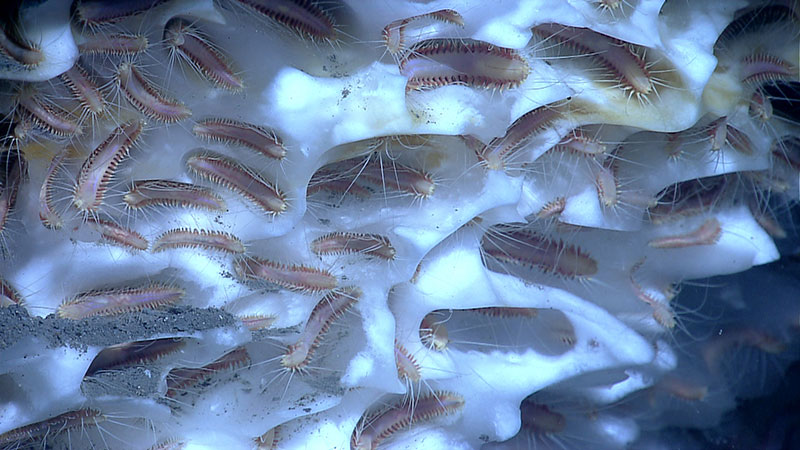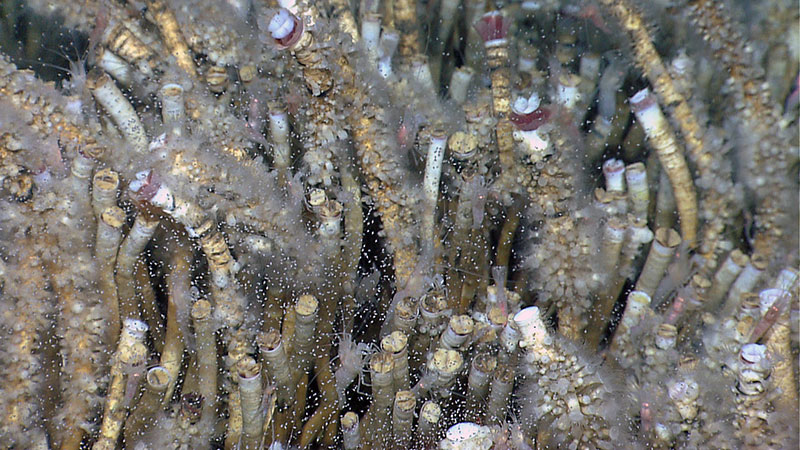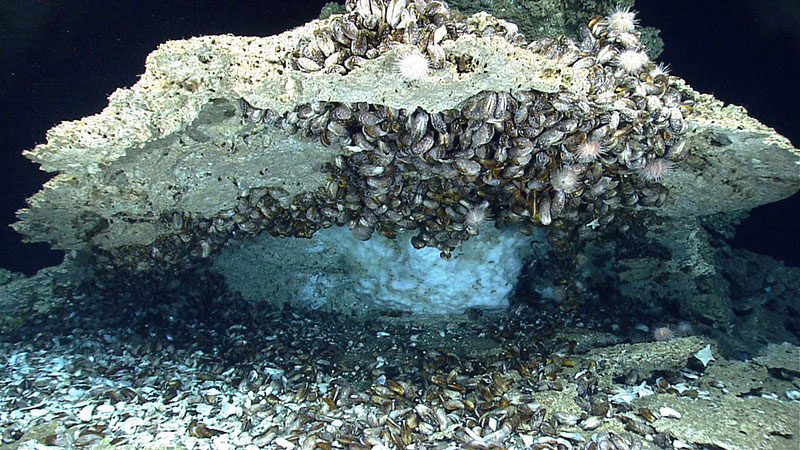
by Diva Amon, Gulf of Mexico 2017 Co-science Lead
Erik Cordes, Temple University

An aggregation of ice worms inhabiting methane hydrate. These worms eat chemoautotrophic bacteria using chemicals in the hydrate. Image courtesy of the NOAA Office of Ocean Exploration and Research, Gulf of Mexico 2012. Download larger version (jpg, 1.3 MB).
In 1983, a deep-sea expedition exploring the Florida Escarpment in the Gulf of Mexico made a fascinating discovery. At over 3,200 meters (2.0 miles), the human occupied vehicle Alvin came upon dense mussel beds, which hosted limpets, snails, sea cucumbers, starfish, brittle stars, eelpout fish, and shrimp. Between the mussel beds were thickets of tubeworms, many of which were over a meter long. Finding these habitats was extraordinary as nearly all the species were new to science and the tubeworms resembled those discovered at hydrothermal vents at the Galapagos Rift just a few years prior.
Since this discovery of what we now call “cold seeps,” our knowledge of these communities has grown immensely. We now understand that these ecosystems exist using chemosynthesis as a source of food. The majority of life on our planet is part of a food web that relies on organisms—mostly plants on land and plankton in the ocean—that use light energy to create food (photosynthesis).
As there is no light in the deep sea, most animals rely on marine snow for food: dead plants, animals, plankton, and fecal matter (literally, poop) that drift thousands of meters from the sea surface to the seafloor. At seeps and vents, bacteria use chemical energy from sulfides, methane, and other hydrocarbons seeping out of fissures on the seafloor to make food (chemosynthesis). These bacteria can be found growing in thick mats, as well as living symbiotically in or on animals, and are the basis of the food chain at cold seeps.

An aggregation of Lamellibrachia sp. tubeworms providing habitat for many smaller animals such as the small white anemones covering the tubeworm tubes and the shrimp Alvinocaris muricola. The tiny white spots all around the tubeworms are copepods, tiny swimming crustaceans. Image courtesy of the NOAA Office of Ocean Exploration and Research, Gulf of Mexico 2012. Download larger version (jpg, 1.6 MB).
Cold seeps are unique because they have a plentiful and readily available food source (bacteria), so animals living there can grow to large sizes rapidly and reproduce quickly, unlike in the rest of the deep sea which is very food limited. As a result, cold seeps are oases of life in the deep sea: patchy areas of huge abundance and biomass of unique endemic animals.
In the Gulf of Mexico, seep communities are dominated by tubeworms reliant on hydrogen sulfide and mussels that use methane. These are foundation species: species that create habitat for other species. They are also considered ecosystem engineers: species that can modify the physical and chemical environment that surrounds them.
Smaller animals such as polychaete worms, shrimp, and snails live within these biogenic structures. There are also usually predators, such as fish, large crabs, and octopus, that roam around in the dark deep sea and find the abundant food at the cold seeps very appealing. Frequently fringing these chemosynthetic communities are filter-feeding species such as sponges, corals, and hydroids, as well as the many species that live on them.
Interestingly, seep communities vary depending on their depth within the Gulf of Mexico. Upper Louisiana Slope (ULS) sites tend to be dominated by Bathymodiolus childressi mussels, with polychaetes, snails, crabs, lobsters, and shrimp living amongst the shells. One of the coolest places they live is at “brine pools” where the very salty water seeping up from below (up to four times the salinity of seawater, and therefore more dense) collects in a basin lined with mussels on the seafloor. Two tubeworm species are also abundant: Lamellibrachia lumeysi and Seepiophila jonesi, as well as another undescribed Escarpia species. The clams Calyptogena ponderosa and Vesicomya chordata are present also. Hesiocaeca methanicola or “ice worms” are commonly seen on ice-like methane hydrates found associated with seeps.

Bathymodiolus mussels (both dead and alive) are seen underneath a carbonate overhang. Also visible under this overhang is methane hydrate. Between the mussels, urchins and sea stars can also be seen. Image courtesy of the NOAA Office of Ocean Exploration and Research, Gulf of Mexico 2014. Download larger version (jpg, 1.7 MB).
Deeper communities (>1,000 meters; 3,280 feet) are less well known but include the largest mussel bed known in the Gulf, actively venting mud volcanoes, asphalt seeps, brine lakes, and a variety of new species. The communities appear similar to the upper slope, but are dominated by different species. Tubeworm aggregations are composed of Escarpia laminata along with two different undescribed tubeworms, Lamellibrachia sp. 2 and Escarpia sp. Three different mussels have been observed: Bathymodiolus childressi, B. brooksi, and B. heckeri (> 2,200 meters; 7,217 feet). The fauna associated with the tubeworms and mussels of the lower slope are also similar to those of the upper slope at higher taxonomic levels, but are very different at the species level. However, brittle stars tend to be the dominant bacteria-feeders in the deeper sites instead of the snails observed at the ULS sites.
During this expedition, we aim to explore several new seeps and the chemosynthetic communities that inhabit them. Collecting this critical baseline information will allow more effective management of this area, especially given the numerous fishing and oil and gas interests in these waters. Will they be similar to known seep sites or will they yield new and exciting life forms and landscapes? You’ll just have to follow along to find out!